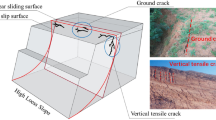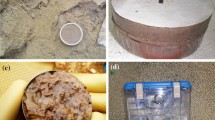Abstract
The cracks caused by tension are commonly observed on the upper border of loess slope. Most researchers assume that shear failure is the main reason for slope instability. The existing cracks and their development are not fully considered. The finite element method is applied widely in the numerical simulations of slope stability, but it converges and time problems must be considered when a crack occurs. The extended finite element method provides a new way to solve discontinuous media problems. In this paper, a composite model of cracking and shear failure is introduced. The extended finite element method was used to simulate the cracking in loess slope. The model used here had a unified enrichment function and the enriched freedom had a clear physical meaning. Numerical analyses were performed and the simulation results showed that the stress field redistributes. The crack propagated almost vertically at the beginning. The slope stability safety factor was less than that obtained without considering tension failure. Furthermore, the critical sliding surface was determined. This model can be used for analyzing the stability of loess slope and provides a reference for slope safety analyses.









Similar content being viewed by others
Abbreviations
- N(x):
-
Shape function
- u(x):
-
Displacement function
- I,J :
-
No. of nodes
- \(\varPsi\) :
-
Level set function of the crack surface
- \(\phi\) :
-
Level set function of the crack tip
- \(\hat{t}\) :
-
Tangent vector of the crack tip
- σ3 :
-
Principal stress
- \(z_{0}\) :
-
Crack depth of retaining wall
- \(\gamma\) :
-
Bulk density
- \(K_{\text{p}}\) :
-
Coefficient of passive pressure
References
D.J. Li et al., Stability analysis of loess slope with hidden hole by numerical methods. Appl. Mech. Mater. 170–173, 306–311 (2012)
D.V. Griffiths, P.A. Lane, Slope stability analysis by finite elements. Geotechnique 49(3), 387–403 (1999)
J.M. Duncan, State of the art: limit equilibrium and finite element analysis of slopes. J. Geotech. Eng. 122(7), 577–595 (1996)
D.Y. Zhu, A method for locating critical slip surfaces in slope stability analysis. Can. Geotech. J. 38(2), 328–337 (2001)
M. Vafaeian, R. Abbaszadeh, Laboratory model tests to study the behavior of soil wall reinforced by weak reinforcing layers. Int. J. Eng. Trans. B Appl. 21(4), 361–373 (2008)
Z. Ding-Bang et al., Physical model test and numerical simulation study of deformation mechanism of wall rock on open pit to underground mining. Int. J. Eng. Trans. B Appl. 27(11), 1795–1802 (2014)
R. Qhaderi, M. Vafaeian, A parametric study of the behavior of geosynthetic reinforced soil slopes. Int. J. Eng. Trans. B Appl. 18(4), 371–389 (2005)
D. Nezamolmolki, A. Aftabi, Free vibration analysis of a sloping-frame: closed-form solution versus finite element solution and modification of the characteristic matrices. Int. J. Eng. Trans. A 28(3), 378–386 (2015)
Z.G. Wang et al., Discussion on the formation mechanism of vertical joints in loess. Sci. China Ser. B 23(7), 765–770 (1993)
Z. Dai, Z. Lium et al., Numerical analysis of soil slope stability considering tension and shear failures. Chin. J. Rock Mech. Eng. 27(2), 375–382 (2008)
X. Jin, L. Chen, Y. Zhang, Application of FEM strength reduction method to geotechnical engineering with the consideration of tension and shear failures. J. Chongqing University. 36(8), 97–104 (2013)
T. Belyschko, T. Black, Elastic crack growth in finite elements with minimal remeshing. Int. J. Numer. Methods Eng. 45, 601–620 (1999)
P. Areias, T. Belytschko, Analysis of three-dimensional crack initiation and propagation using the extended finite element method. Int. J. Numer. Methods Eng. 63(5), 760–788 (2005)
P.F. Liu, B.J. Zhang, J.Y. Zheng, Finite element analysis of plastic collapse and crack behavior of steel pressure vessels and piping using XFEM. J. Fail. Anal. Prev. 12(6), 707–718 (2012)
M. Toolabi et al., Dynamic analysis of a viscoelastic orthotropic cracked body using the extended finite element method. Eng. Fract. Mech. 109, 17–32 (2013)
J.H. Song, P.M.A. Areias, T. Belytschko, A method for dynamic crack and shear band propagation with phantom nodes. Int. J. Numer. Methods Eng. 67, 868–893 (2006)
Stolarska et al., Modelling crack growth by level sets in the extended finite element method. Int. J. Numer. Methods Eng. 51(8), 943–960 (2001)
Y.U. Jialin et al., Integration scheme for discontinuities in the extended finite element method. J. Tsinghua University. 49(3), 351–354 (2009)
J.M. Chang, H.P. Feng, Crack growth simulation in concrete beam based on extended isoparametric finite element method under quadrature without sub-area. J. Shijiazhuang Tiedao University. 26(3), 91–93 (2013)
Y.S. Zhang, H.C. Wang, Numerical simulation of the stability of high sand loess slopes. J. Geomech. 10(4), 357–365 (2004)
Acknowledgments
This project is financially supported by the Natural Science Foundation of China (51478279) and the Scientific Research Foundation of Hebei Education Department (QN2015117). We gratefully acknowledge the assistance of the members in the Unsaturated Lab in Shijiazhuang Tiedao University.
Author information
Authors and Affiliations
Corresponding author
Rights and permissions
About this article
Cite this article
Chang, J., Song, S. & Feng, H. Analysis of Loess Slope Stability Considering Cracking and Shear Failures. J Fail. Anal. and Preven. 16, 982–989 (2016). https://doi.org/10.1007/s11668-016-0174-2
Received:
Revised:
Published:
Issue Date:
DOI: https://doi.org/10.1007/s11668-016-0174-2




